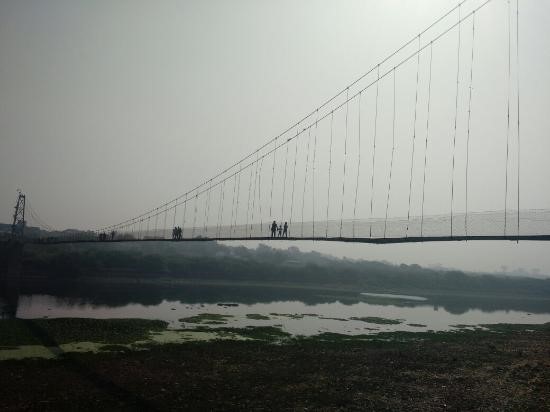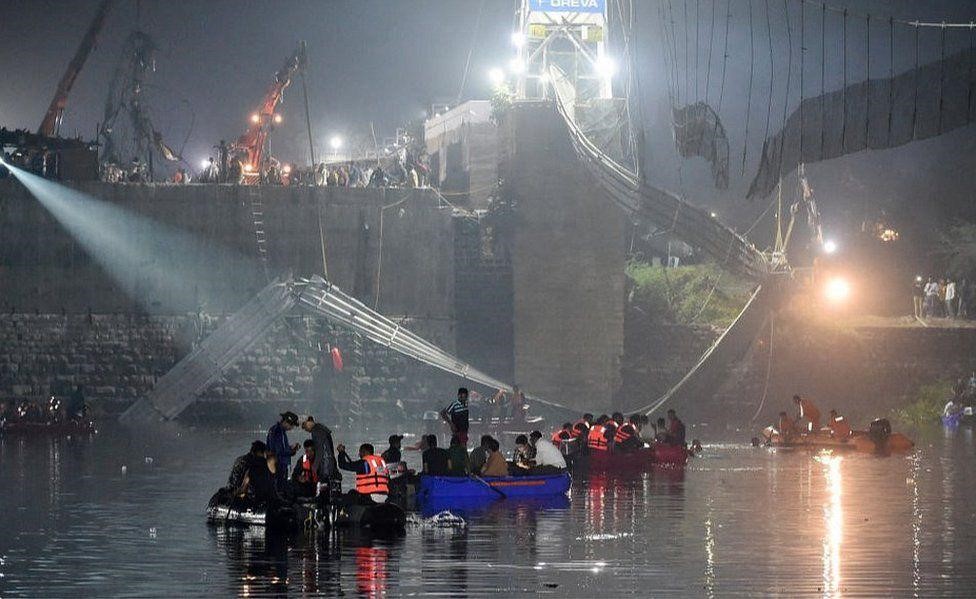On 30th October Sunday evening, the residents of Morbi, a small town in Gujarat witnessed one of the worst tragedies in India. Julto Pul (hanging bridge) in Morbi collapsed into the Machchu river, while 500 people were standing on it.
Julto Pul was a pedestrian suspension bridge, constructed in the 19th century under British rule, linking the districts of Mahaprabhuji and Samakantha over the Machchhu River. Historically, It linked the former royal houses of the Morbi State, Darbargadh Palace, and Nazarbag Palace (now Lukhdhirji Engineering College). At that time, owing to its design and small capacity, only 15 people could stand on it at one time. The bridge often wavered under heavier loads.

The bridge, formerly owned and managed by the Morbi municipality as a toll bridge recently entered into a contract with Oreva under its flagship business Ajanta Manufacturing Private Limited. Previously Oreva was responsible for the maintenance and management of the bridge under a 15 years contract. The bridge had been closed for 6 months due to maintenance work.
It was reopened on 26th October 2022 on the Gujarati new year. The reopening event was a massive success with the managing director of Oreva boasting that the bridge would not require any maintenance for the next 8-10 years.
However, investigations revealed that the bridge was repaired and reopened before it received the necessary certificate of fitness from the local civic authority.
Moments leading up to the tragedy
At the moment of the bridge’s collapse, there were more than 500 people on it, significantly more than the 125 that it was designed to hold.
That evening, more than 700 passes were given out to allow access to the bridge, and a sizable crowd had gathered there.
Security footage of the bridge showed people clinging to wires and fences on each side of it as the bridge violently shook before the walkway caved in. Scores of people fell into a river, while still hanging from the bridge after the accident. Many were crushed by the broken parts of the bridge. Photos taken during rescue and recovery efforts revealed that the walkway had split in half, with some portions still dangling from broken wires.

An eyewitness, a tea stall vendor shared, “I sell tea there every Sunday. People were hanging from cables and then they slipped. I didn’t sleep and we helped people the entire night. It was heart-breaking to see a 7-8-month-pregnant woman die.”
This incident killed 141 people, the majority of which included children, women, and the elderly. A witness to the disaster claimed that some naughty kids were rattling the bridge’s ropes just before it collapsed, killing roughly 140 people and wounding over 100 more.
After the disaster occurred, rescue teams—including members of the armed forces and the NDRF (National Disaster Response Force)—were dispatched to the scene, and work was done all night.
The Gujarati government has made promises to provide ex gratia payout of 4 lakh to each deceased person’s next of kin and 50,000 to each injured person.
Investigation
Nine persons connected to Oreva have been detained by the police since the accident on Sunday, including two managers, two ticket clerks, two contractors, and three security guards that Oreva had employed.
They are being looked at for culpable but not murderous homicide. Public prosecutor HS Panchal said during a news conference on Wednesday that the two contractors who had been assigned fabrication work by Oreva were “unqualified” for the job. Many officers reported that the cables of the bridge were rusted.
The Blame game
Had the crowd on the bridge been controlled, the accident would have been avoided. Neither the Gujarat government nor the civic authorities maintained track of how the bridge was being used or tried to assess the condition of the bridge. While the prosecutors are holding Oreva accountable for its carelessness concerning the bridge’s repair and upkeep, one of the defendants defended himself in court by asserting that the catastrophe was the “will of God.”
This kind of constant blame game against one another only deviates the public’s attention from the actual problem.

The collapse of Julto Pul is yet another example of India’s pitiful track record of controlling huge crowds in public areas. Similar tragic occurrences include the 2013 stampede in Madhya Pradesh’s Datia district, where 115 people died after hearing a rumor that a river bridge was about to collapse; the 2017 stampede on a constrained foot overbridge at Mumbai’s Elphinstone station; the stampede at the Vaishno Devi shrine in January of this year; and countless other train derailments.
The main culprits are the local government, civic authorities, and Oreva, who not only employed unqualified contractors but also reopened it prior to receiving a fitness certificate. There were human faces behind the catastrophe, regardless of whether it was an “Act of God”. People lost their lives and families were shattered. We can only avert disasters in the future by taking responsibility for our actions and refraining from repeating them.
Written by Arshia Singha
Edited by Diksha Rajput
